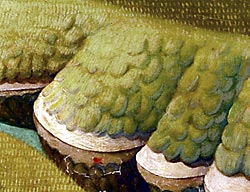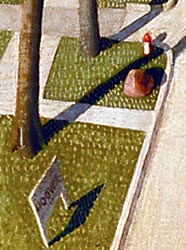
Grant Wood
1931
Oil on composition board
The John R. Van Derlip Fund; owned jointly with the Des Moines Art Center
|
Grant Wood
The artist Grant Wood is something of a legend himself, another small-town Iowa boy made good. Wood studied art in Europe for several
years but returned to the United States in the 1920s. Dissatisfied with modern painting styles, he developed his own style inspired by
the brilliant colors and tiny details of 15th-century Flemish paintings.
Responding to a resurgence of nationalism and a new fascination with the American past, Wood painted many GENRE scenes of historical and
regional subjects, including farmhouses, small-town folk, and the rural landscape. He and other midwestern artists who painted scenes
of Americana were called Regionalists. Wood emphasized description and narrative in the same way as the contemporary American writers
he admired. Like Sinclair Lewis, he raised ordinary experiences of daily life in small town America to mythical proportions. |
|
The Birthplace of Herbert Hoover, West Branch, Iowa
Wood places the viewer at the crest of a steep hill, looking down into a green valley where a tour guide points to a small cottage
beside a larger white house. But this is not an ordinary cottage - it is the place where Herbert Hoover was born.
Warm midwestern sunshine illuminates the large family homes, neatly mown lawns, and perfectly clipped trees in the quiet neighborhood
surrounding the cottage. A gentle breeze blows laundry hanging near the cottage. In the front, three orange birds fly over a clear blue
stream. Beyond them, toylike chickens peck around logs leaning against a red barn, and even farther back, two boys in overalls chat on
the sidewalk. A road runs between rows of shade trees on the right, and a golden field, dotted with haystacks, extends beyond the houses
on the left.

|
Detail of brushstrokes from The Birthplace Of Herbert Hoover, West Branch, Iowa |
Typical of Grant Wood's Regionalist style, everything is neat and regimented, evoking the simplified forms of American folk art. Many tiny
straight brushstrokes define the trim lawns, creating a rhythmic pattern across much of the painting, and patterned clumps of enormous
autumnal leaves define the trees. Unrealistically, all of the forms, whether close or distant, are bathed in the same clear light and
described with the same precise detail.
Warm autumnal colors - browns, golds, oranges, and yellow-greens - dominate Wood's painting. The white siding of the cottage and house create
a striking contrast against the golden-green lawn.

|
Detail of sign and pink rock from The Birthplace Of Herbert Hoover, West Branch, Iowa |
Hoover's Birthplace
Wood did not re-create the scene as it may have looked at the president's birth. Instead he painted it as the tourist attraction it
had become. Upon Hoover's election to the presidency, the ordinary cottage, which had been turned into a kitchen by later owners, began
to attract visitors from all over the country. The owner of the cottage charged visitors ten cents for tours of it and set up a souvenir
stand. Wood included a sign in front of the house and a pink rock in which the Daughters of the American Revolution had placed a plaque
identifying the house as Hoover's birthplace.
|











